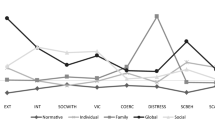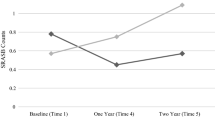Abstract
Over the past 5 years, a great deal of attention has been paid to the development of early warning systems for dropout prevention. These warning systems use a set of indicators based on official school records to identify youth at risk for dropout and then appropriately target intervention. The current study builds on this work by assessing the extent to which a school disengagement warning index predicts not only dropout but also other problem behaviors during middle adolescence, late adolescence, and early adulthood. Data from the Rochester Youth Development Study (N = 911, 73% male, 68% African American, and 17% Latino) were used to examine the effects of a school disengagement warning index based on official 8th and 9th grade school records on subsequent dropout, as well as serious delinquency, official offending, and problem substance use during middle adolescence, late adolescence, and early adulthood. Results indicate that the school disengagement warning index is robustly related to dropout as well as serious problem behaviors across the three developmental stages, even after controlling for important potential confounders. High school dropout mediates the effect of the warning index on serious problem behaviors in early adulthood.





Similar content being viewed by others
References
American Psychiatric Association. (1994). Diagnostic and statistical manual of mental disorders (4th ed.). Washington, DC: American Psychiatric Association.
Bachman, J. G., O’Malley, P. M., Schulenberg, J. E., Johnston, L. D., Freedman-Doan, P., & Messersmith, E. E. (2008). The education-drug use connection: How successes and failures in school relate to adolescent smoking, drinking, drug use, and delinquency. New York, NY: Taylor & Francis Group/Lawrence Erlbaum Associates.
Bond, L., Butler, H., Thomas, L., Carlin, J., Glover, S., Bowes, G., et al. (2007). Social and school connectedness in early secondary school as predictors of late teenage substance use, mental health, and academic outcomes. Journal of Adolescent Health, 40(4), 357.e9–357.e18.
Borowsky, I., Ireland, M., & Resnick, M. (2002). Violence risk and protective factors among youth held back in school. Ambulatory Pediatrics, 2(6), 475–484.
Cernkovich, S. A., & Giordano, P. C. (1992). School bonding, race, and delinquency. Criminology, 30(2), 261–291.
Dishion, T. J., Nelson, S. E., & Yasui, M. (2005). Predicting early adolescent gang involvement from middle school adaptation. Journal of Clinical Child and Adolescent Psychology, 34(1), 62–73.
Drapela, L. A. (2005). Does dropping out of high school cause deviant behavior? An analysis of the national education longitudinal study. Deviant Behavior, 26(1), 47–62.
Editorial Projects in Education Research Center. (2009). National graduation brief 2009. Bethesda, MD: Editorial Projects in Education.
Elliott, D. S., & Voss, H. L. (1974). Delinquency and dropout. Lexington, MA: D.C. Heath.
Farrington, D. P. (1989). Early predictors of adolescent aggression and adult violence. Violence and Victims, 4(2), 79–100.
Farrington, D. P. (Ed.). (2005). Integrated developmental and life-course theories of offending: Advances in criminological theory (Vol. 14). New Brunswick, NJ: Transaction.
Henry, K. L. (2010). Academic achievement and adolescent drug use: An examination of reciprocal effects and correlated growth trajectories. Journal of School Health, 80(1), 38–43.
Henry, K. L., & Huizinga, D. H. (2007). Truancy’s effect on the onset of drug use among urban adolescents placed at-risk. Journal of Adolescent Health, 40(4), e9–e17.
Henry, K. L., & Thornberry, T. P. (2010). Truancy and escalation of substance use during adolescence. Journal of Studies on Alcohol and Drugs, 71(1), 115–124.
Henry, K. L., Thornberry, T. P., & Huizinga, D. H. (2009). A discrete time-survival analysis of the relationship between truancy and the onset of marijuana use. Journal of Studies on Alcohol and Drugs, 70(1), 5–15.
Heppen, J. B., & Bowles Therriault, S. (2008). Developing early warning systems. National High School Center. American Research Institues. http://www.betterhighschools.org/pubs/documents/IssueBrief_EarlyWarningSystemsGuide.pdf.
Herrenkohl, T. I., Hill, K. G., Chung, I., Guo, J., Abbott, R. D., & Hawkins, J. D. (2003). Protective factors against serious violent behavior in adolescence: A prospective study of aggressive children. Social Work Research, 27(3), 179–191.
Hudson, W. H. (1996). WALMYR assessment scales scoring manual. Tempe, AZ: WALMYR.
Jarjoura, G. R. (1993). Does dropping out of school enhance delinquent involvement? Results from a large-scale national probability sample. Criminology, 31(2), 149–172.
MacKinnon, D. P. (2008). Introduction to statistical mediation analysis. New York, NY: Taylor & Francis Group/Lawrence Erlbaum Associates.
Moretti, E. (2005). Does education reduce participation in criminal activities? In H. M. Levin (Chair), Symposium on the social costs of inadequate education conducted at Teachers College. New York: Columbia University.
Muennig, P. (2005). Health returns to education interventions. In H. M. Levin (Chair), Symposium on the social costs of inadequate education conducted at Teachers College. New York: Columbia University.
Muthén, L. K., & Muthén, B. O. (1998–2010). Mplus user’s guide (6th ed.). Los Angeles, CA: Muthén & Muthén.
Neild, R. C., Balfanz, R., & Herzog, L. (2007). An early warning system. Educational Leadership, 65, 28–33.
O’Donnell, J., Hawkins, J. D., & Abbott, R. D. (1995). Predicting serious delinquency and substance use among aggressive boys: Prediction and prevention of child and adolescent antisocial behavior. Journal of Consulting and Clinical Psychology, 63(4), 529–537.
Payne, A. A., Gottfredson, D. C., & Gottfredson, G. D. (2003). Schools as communities: The relationships among communal school organization, student bonding, and school disorder. Criminology, 41(3), 749–777.
Resnick, M. D., Bearman, P. S., Blum, R. W., Bauman, K. E., Harris, K. M., Jones, J., et al. (1997). Protecting adolescents from harm—Findings from the national longitudinal study on adolescent health. Journal of the American Medical Association, 278(10), 823–832.
Rouse, C. E. (2005). The labor market consequences of an inadequate education. In H. M. Levin (Chair), Symposium on the social costs of inadequate education conducted at Teachers College. New York: Columbia University.
Rubin, D. B. (1987). Multiple imputation for nonresponse in surveys. New York: Wiley.
Simons-Morton, B. G., Crump, A. D., Haynie, D. L., & Saylor, K. E. (1999). Student-school bonding and adolescent problem behavior. Health Education Research, 14(1), 99–107.
Sweeten, G., Bushway, S. D., & Paternoster, R. (2009). Does dropping out of school mean dropping into delinquency? Criminology, 47(1), 47–91.
Thornberry, T. P., & Krohn, M. D. (2005). Applying interactional theory to the explanation of continuity and change in antisocial behavior. In D. P. Farrington (Ed.), Integrated developmental and life-course theories of offending (pp. 183–209). New Brunswick, NJ: Transaction Publishers.
Thornberry, T. P., Moore, M., & Christenson, R. L. (1985). The effect of dropping out of high school on subsequent criminal behavior. Criminology, 23(1), 3–18.
U. S. Department of Education. (2010). U.S. Department of Education, National Center for Education Statistics, National Assessment of Educational Progress (NAEP). Available online at http://nces.ed.gov/nationsreportcard/.
Waldfogel, J., Garfinkel, I., & Kelly, B. (2005). Public assistance programs: How much could be saved with improved education? In H. M. Levin (Chair), Symposium on the social costs of inadequate education conducted at Teachers College. New York: Columbia University.
Weerman, F. M., Harland, P., & van der Laan, P. H. (2007). Misbehavior at school and delinquency elsewhere: A complex relationship. Criminal Justice Review, 32(4), 358–379.
Woolf, S. H. (2007). Giving everyone the health of the educated: An examination of whether social change would save more lives than medical advances. American Journal of Public Health, 97, 679–683.
Acknowledgments
Support for the Rochester Youth Development Study has been provided by the Office of Juvenile Justice and Delinquency Prevention (86-JN-CX-0007), the National Institute on Drug Abuse (R01 DA005512, K01 DA017810), and the National Science Foundation (SBR-9123299, SES-9123299). Work on this project was also aided by grants to the Center for Social and Demographic Analysis at the University at Albany from NICHD (P30-HD32041) and NSF (SBR-9512290). Official arrest data was provided electronically by the New York State Division of Criminal Justice Services. Points of view, conclusions, and methodological strategies in this document are those of the authors and do not necessarily represent the official position or policies of the funding agencies or data sources.
Author information
Authors and Affiliations
Corresponding author
Rights and permissions
About this article
Cite this article
Henry, K.L., Knight, K.E. & Thornberry, T.P. School Disengagement as a Predictor of Dropout, Delinquency, and Problem Substance Use During Adolescence and Early Adulthood. J Youth Adolescence 41, 156–166 (2012). https://doi.org/10.1007/s10964-011-9665-3
Received:
Accepted:
Published:
Issue Date:
DOI: https://doi.org/10.1007/s10964-011-9665-3




